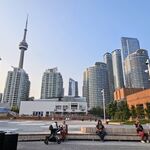denfromoakvillemilton
Senior Member
Member Bio
- Joined
- Apr 30, 2008
- Messages
- 7,474
- Reaction score
- 1,533
- Location
- Downtown Toronto, Ontario
What will Toronto be like in 2030.
What change's will have been made. What will stay the same?
Transit, Political, Social, Health all applicable to this thread.
What change's will have been made. What will stay the same?
Transit, Political, Social, Health all applicable to this thread.




